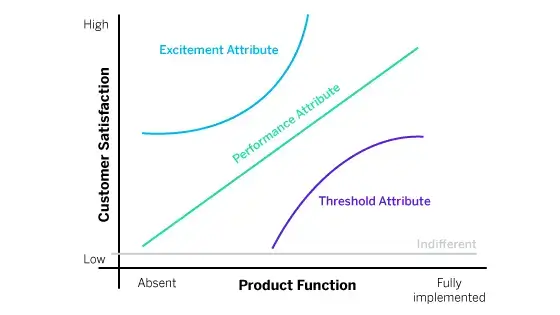Introduction
Customer satisfaction is a cornerstone of successful business strategy. Understanding and addressing the diverse needs and expectations of customers can set a business apart from its competitors. The Kano Model, developed by Dr. Noriaki Kano, provides a valuable framework for categorizing and prioritizing these needs. This blog delves into the intricacies of the Kano Model, exploring its key components—Threshold Attributes, Performance Attributes, Excitement Attributes, and Indifferent Attributes—and highlighting its practical applications in enhancing customer satisfaction.
In today’s highly competitive market, businesses strive to understand and meet customer expectations effectively. The Kano Model of Customer Satisfaction, introduced by Japanese quality management guru Dr. Noriaki Kano in the 1980s, offers a systematic approach to achieve this goal. By categorizing product or service attributes based on how they influence customer satisfaction, the Kano Model helps businesses prioritize their development efforts to maximize customer delight and loyalty.
Parag Sir’s insight on Kano’s Model
Parag Gupta Sir breaks down the intricacies of the Kano Model, explaining its core principles and illustrating its importance in the realm of customer satisfaction and quality management. Watch this video to get a great insight on this topic:
Product attributes based on Kano’s model
Threshold Attributes
Threshold Attributes, also known as Basic Attributes or Must-Be Attributes, are the fundamental features that customers expect in a product or service. These attributes are not typically vocalized by customers because their presence is assumed. However, their absence leads to significant dissatisfaction.
For example, consider a smartphone. Basic features like calling, texting, and reliable battery life are expected. If these features are missing or fail to meet basic standards, customers will be dissatisfied regardless of how impressive other features might be. Hence, businesses must ensure these essential attributes are consistently delivered and meet a minimum standard of quality.
Performance Attributes
Performance Attributes, or One-Dimensional Attributes, are those features that directly correlate with customer satisfaction. The better these attributes perform, the more satisfied the customers will be. Conversely, poor performance in these areas leads to dissatisfaction.
Using the smartphone example again, performance attributes might include camera quality, processing speed, and screen resolution. Enhancing these attributes generally leads to higher customer satisfaction because customers can clearly see the benefits and improvements. Businesses should focus on continuously improving these attributes to stay competitive.
Excitement Attributes
Excitement Attributes, also known as Attractive Attributes, are the features that surprise and delight customers. These are unexpected and not typically demanded by customers, but their presence generates significant satisfaction. Conversely, their absence does not cause dissatisfaction because customers do not expect them.
For instance, an innovative facial recognition feature in a smartphone can be considered an Excitement Attribute. When first introduced, it wasn’t an expected feature, but it created a “wow” factor and set the product apart from its competitors. Investing in these attributes can turn customers into enthusiastic promoters of the product or service.
Indifferent Attributes
Indifferent Attributes are features that neither contribute to customer satisfaction nor cause dissatisfaction. These attributes have little to no impact on how customers perceive the product or service.
An example might be the color of the internal components of a smartphone. Most customers are indifferent to such aspects as they do not affect the user experience. Identifying and minimizing resources spent on Indifferent Attributes can help businesses allocate their efforts more effectively towards attributes that enhance customer satisfaction.
Uses
The Kano Model serves multiple purposes in the realm of customer satisfaction and product development:
- Prioritization of Features: By categorizing features into Threshold, Performance, Excitement, and Indifferent Attributes, businesses can prioritize which features to develop and enhance.
- Resource Allocation: Understanding which features impact customer satisfaction helps businesses allocate resources more effectively, focusing on high-impact areas.
- Strategic Planning: The model aids in long-term strategic planning by identifying which features to maintain, improve, or innovate to stay ahead of customer expectations.
- Customer Segmentation: It helps in segmenting customers based on their needs and expectations, allowing for more targeted marketing and product development strategies.
- Competitive Advantage: By continuously improving Performance Attributes and introducing Excitement Attributes, businesses can differentiate themselves from competitors and foster customer loyalty.
Conclusion
The Kano Model of Customer Satisfaction is a powerful tool for understanding and prioritizing customer needs. By categorizing features into Threshold, Performance, Excitement, and Indifferent Attributes, businesses can strategically enhance their offerings to maximize customer satisfaction and loyalty. Utilizing the Kano Model can lead to more effective resource allocation, better strategic planning, and ultimately, a stronger competitive advantage in the market. In an era where customer expectations are constantly evolving, the Kano Model provides a structured approach to staying ahead and continuously delighting customers.
FAQs
Pronounced “Kah-no,” the Kano Analysis model (sometimes called the “Customer Delight vs. Implementation Investment” method) is a technique for analysis that helps you comprehend how you may evaluate and investigate consumer emotional responses to features or goods.
Five categories are included in the Kano Model: basic, excitement/delighters, performance/satisfiers, neutral qualities, and reverse attributes. Users place varying degrees of value on each of these. A product may have less functionality and annoy customers if it is missing some essential features.
Product managers frequently categorise prospective new features using the Kano Model to prioritise them. These feature categories might include those that are likely to satisfy or even excite clients, as well as those that could disappoint them.
According to Kano, a good or service is about much more than merely workings. It also involves the feelings of the clients. When a consumer purchases a new automobile, for instance, they all expect it to stop when they apply the brakes, but many will be pleasantly surprised by the voice-activated parking assistance system.
